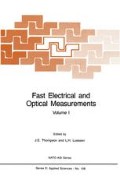Abstract
Electro-optical voltage measurement techniques, based on the Kerr and Pockels effects, offer a number of advantages over conventional resistive or capacitive voltage dividers. As with all electron analog sensors, their performance is affected by EMI, ground loops, and noise pickup; and their frequency response is limited by stray capacitance and inductance associated with the divider circuits. Optical analog sensors are not susceptible to these perturbations and are often considered superior [1]. One of the most outstanding characteristics of optical analog sensors is their inherent band width; for example, the intrinsic response time of Kerr fluids is measured in picoseconds [1]. In practice, however, the cells are placed between electrodes and the associated capacitance usually limits the sensor band width to less than 1 GHz. In addition, electrodes may introduce electrical breakdown along the surface of the cell. These concerns are contributing factors to the under utilization of the electro-optic techniques in pulse power research and systems.
Access this chapter
Tax calculation will be finalised at checkout
Purchases are for personal use only
Preview
Unable to display preview. Download preview PDF.
References
Thompson, J. E., Proceeding of the Workshop on Measurements of Electrical Quantities in Pulse Power Systems, NBS, Boulder, Colorado, P. 1, March, 1981.
Hamamatsu Model C1370, Hamamatsu Corp., 420 South Avenue, Middlesex, New Jersey 08846.
Yariv, A., Introduction to Optical Electronics, Holt, Rinehart, and Winston, 1971.
Adhave, R. S., J. Opt. Soc. Am. 59, 414, (1969).
D. E. Merewether and R. Fisher, Finite Difference Solution of Maxwell’s Equations for EMP Applications, Defense Nuclear Agency Report DNA 5301F, April 22, 1980.
L. T. Simpson, R. Holland, and S. Arman, Treatment of LateTime Instabilities in Finite-Difference EMP Scattering Codes, IEEE Trans Nuc Sci. NS-29, pp. 1943–1948, December 1982.
J. D. Jackson, Classical Electrodynamics, John Wiley and Sons, Inc., 1975, p. 151.
Author information
Authors and Affiliations
Editor information
Editors and Affiliations
Rights and permissions
Copyright information
© 1986 Springer Science+Business Media Dordrecht
About this chapter
Cite this chapter
Chang, J., Vittitoe, C.N. (1986). An Electro-Optical Technique for Measuring High Frequency Free Space Electric Fields. In: Thompson, J.E., Luessen, L.H. (eds) Fast Electrical and Optical Measurements. NATO ASI Series, vol 108/109. Springer, Dordrecht. https://doi.org/10.1007/978-94-017-0445-8_5
Download citation
DOI: https://doi.org/10.1007/978-94-017-0445-8_5
Publisher Name: Springer, Dordrecht
Print ISBN: 978-94-017-0447-2
Online ISBN: 978-94-017-0445-8
eBook Packages: Springer Book Archive

